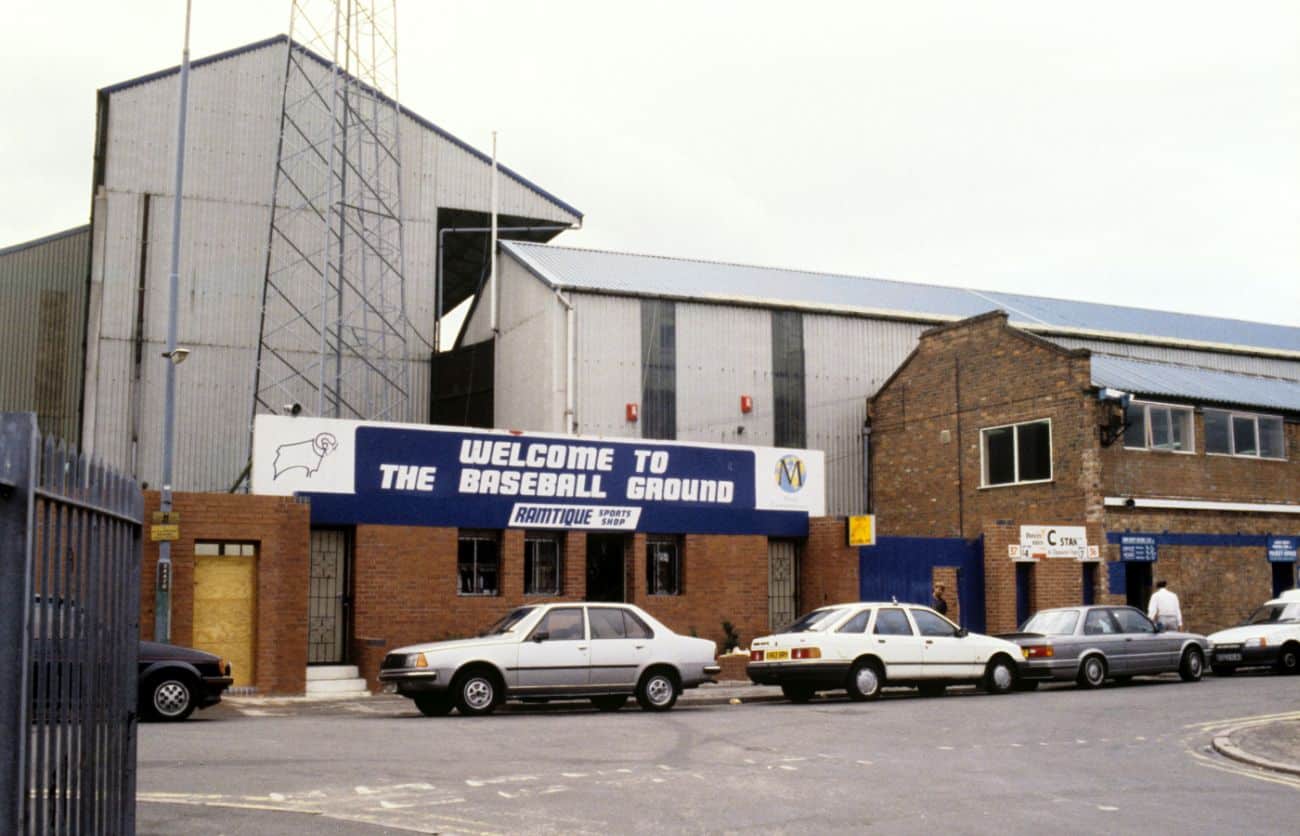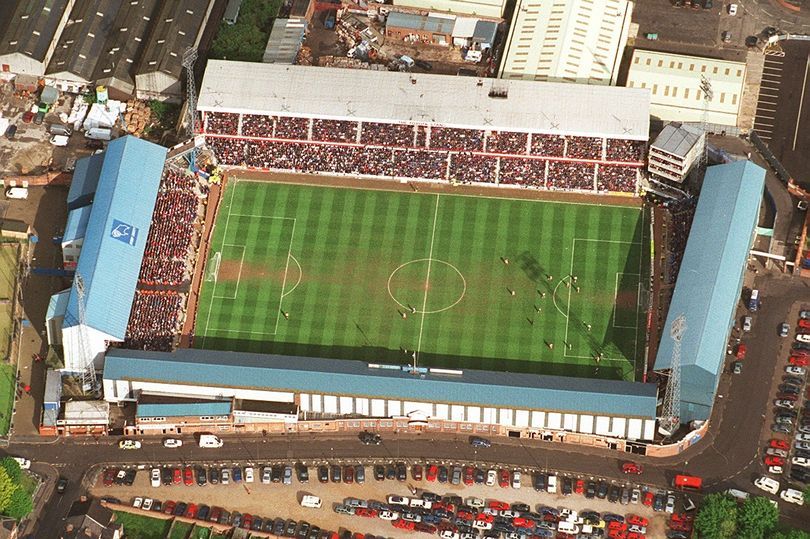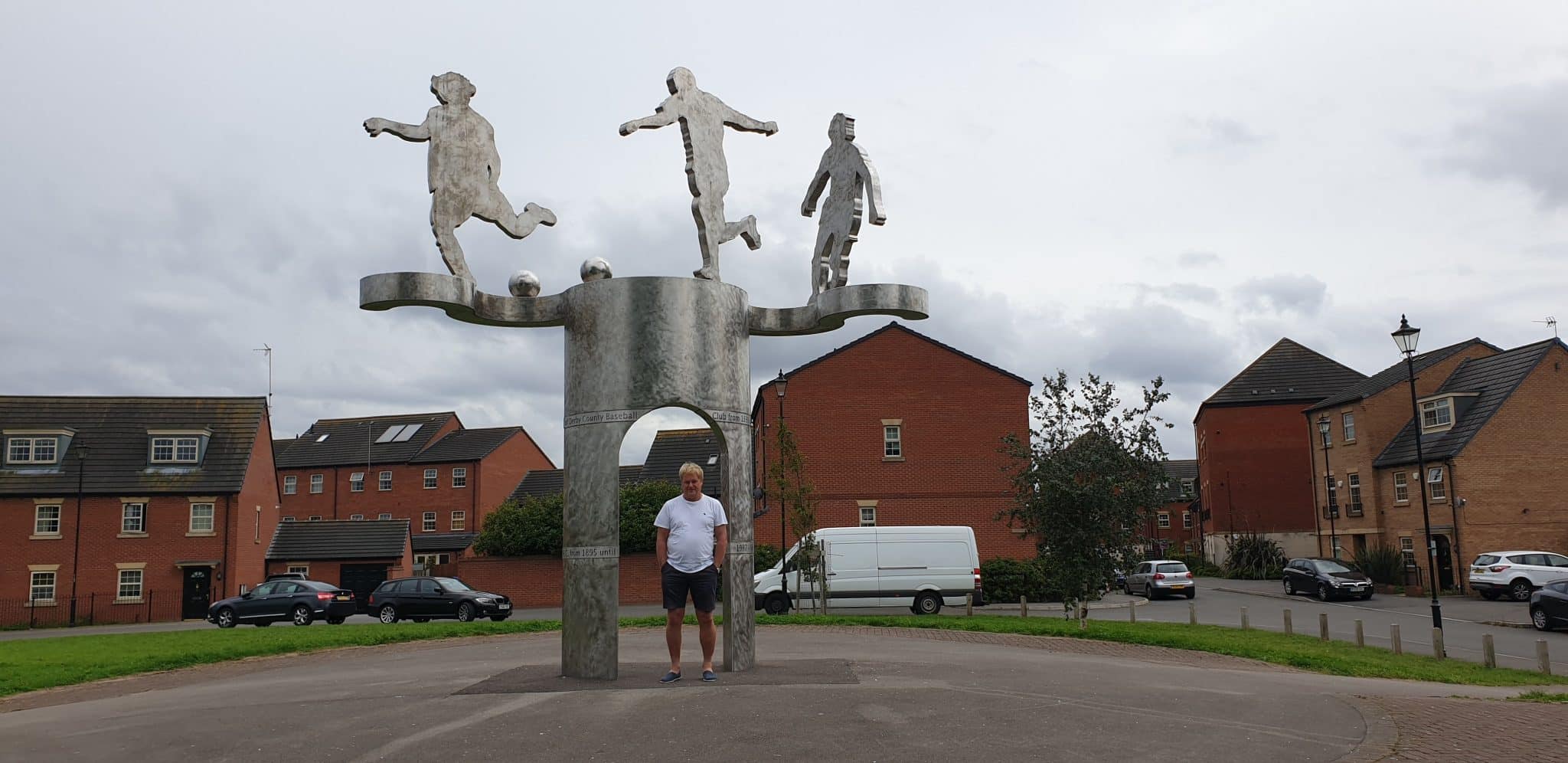See 0 reviews
Submit a review
Baseball Ground Stadium facts
Ground Opened: 1890
Ground Closed: 2003
Number of years at ground: 102
First Competitive Game Played: Derby County 2 Sunderland 0, 14th September 1895.
Last Competitive Game Played: Derby County 1 Arsenal 3, Premier League, 11th May 1997. Attendance 18.287.
Record Attendance: 41,826 vs Tottenham Hotspur. Division 1, 20th September, 1969.
Club moved to: Pride Park in 1997
Distance from Baseball Ground to new Pride Park: 2 miles
The Baseball Ground was known for its unique floodlights, which were mounted on the corners of the stands rather than on pylons. This gave the ground a distinctive look and made it very easy for fans to identify the stadium when watching at home on television.
One of the most famous features of The Baseball Ground was the ‘Pop Side’ which was a large terrace in the Ley Stand. The Pop Side was known for its lively atmosphere and was a popular spot for Derby County’s most passionate fans.
Given its strange name for a football stadium, it may also be unsurprising to learn that the site was originally used for baseball, and for that reason, not all the stands lined up perfectly with the pitch – giving the ground an unusual shape.
Ley Stand at the Baseball Ground
The Ley Stand was the name of the stadium’s east stand and had a capacity of approximately 5,000. It consisted of the infamous ‘Pop Side’ – a large terrace that was often the home of the most passionate Derby County fans and therefore had an incredible atmosphere. The terrace was split into three sections, with the family area sandwiched between two other areas known as Vulcan and Columbo. There were also co-op stands situated above the terrace, with the top tier comprised of executive boxes.
West Stand at the Baseball Ground
The West stand, occasionally referred to as the Railway End, was a two-tiered section of the ground that consisted of a paddock-seating lower tier, with a further three sections, named the A, B and C stands respectively completing the upper tier.
Osmaston End at the Baseball Ground
The North Stand at the ground was widely known as the Osmaston Stand. It had a capacity of approximately 3,000. Constructed in 1933, the double-decker stand built within the Osmaston End allowed the club to cater for an increased demand for tickets from fans, although it only made up a portion of the end rather than running the entire width. Its facilities also included a small hut and platform which was used to display scores.
Normanton End at the Baseball Ground
The Baseball Ground’s South Stand, better known as the Normanton End, was built just two years after the double-decker stand at the opposite end of the pitch in 1935. Similar in design to its counterpart, the Normanton End had an approximate capacity of 7,000. Tragically, this section of the stadium was heavily damaged during World War Two, after it fell victim to a German air raid in 1941 and wasn’t repaired until many years after the incident.
Initial issues with contaminated land at Pride Park meant that the club had originally favoured the option of expanding the Baseball Ground, rather than moving to a new location.
However, when those plans were abandoned in 1996, Pride Park was finally confirmed as the club’s new home, and the Baseball Ground would shut its doors to competitive first-team football in 1997, after a 3-1 defeat at the hands of Arsenal.
Although it was still used to host youth reserve team football matches, the facility was eventually demolished in late 2003 and was to be replaced with a housing complex. Nowadays, approximately 150 homes occupy the area and also boasts a commemorative statue of the original stadium.
Baseball Ground Then and Now




The Baseball Ground was originally built for baseball, not football. The stadium was constructed in 1890 and was home to the Derby Baseball Club. The football club didn’t move in until 1895.
The Baseball Ground was known for its unique shape. The stadium was built on a triangular plot of land, which meant that one of the stands was shorter than the others. This made for some interesting viewing angles for fans in that stand.
Derby County’s Baseball Ground had a capacity of 18,300, but this was later reduced to just 17,451 by the time it closed due to safety concerns. But, the capacity at the stadium had ebbed and flowed throughout its lifetime, originally hosting a crowd of just 10,000 spectators at its first match.
In the early 1900s, the facility then saw its maximum capacity rise to approximately 20,000, and the construction of a double-decker stand in the Ormaston End, as well as the development of the Normanton End, saw that figure rise sharply to 38,000. When the Ley Stand was then introduced above the Pop Side, the ground suddenly broke the 40,000 capacity threshold.
However, after the Taylor Report’s finding required clubs to make the transition to an all-seater stadium, this figure was greatly reduced and crowds at the Baseball Ground were forced to become less than half of that figure of 40,000.
Despite that reduction in size, the intimidating atmosphere at the ground was just as present, with the Derby County faithful ensuring its legacy as a lively stadium lived on.
Unfortunately, the Rams were unable to give the stadium the send-off it undoubtedly deserved, with the final competitive match taking place at the ground resulting in a 3-1 defeat for the club at the hands of Arsenal. Despite taking the lead early on via an Ashley Ward goal in the ninth minute, two goals from Ian Wright and a third from Dennis Bergkamp saw life at the ground come to a frustrating end.
In spite of that disappointment, the campaign was actually a rather impressive one for the club, who managed a 12th-place finish that season despite it being their first time ever competing in the Premier League.
Reviews
Be the first to leave a review of Baseball Ground (Derby County, 1895-1997)!
Why not write your own review of this ground and have it included in the Guide? Find out more about submitting a Fans Football Ground Review.